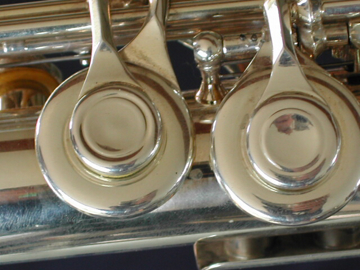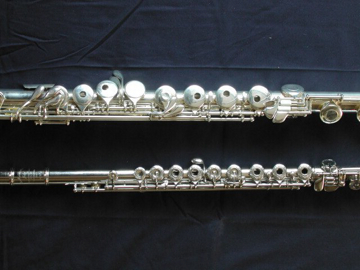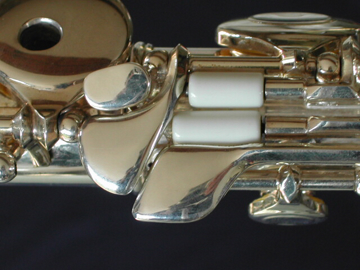Types of alto flute
There are essentially three main types of alto flute; the standard closed hole alto, the open hole alto and the Kingma System alto. All have either curved or straight headjoints and footjoints to c' (sounding g); some players have extended footjoints to take the range to sounding f# but this is still relatively unusual.
1. Standard (closed-hole) alto flute
This is the most common instrument, and comes in a range of bore sizes and key configurations according to the designs of the individual makers. The closed hole alto flute has a number of limitations in terms of contemporary techniques. The lack of open holes restricts the number of multiphonic possibilities, in addition to the options for alternative fingerings, timbral trills and pitch flexibility. Also, different bore sizes and key configurations mean that a technique that works well on one instrument may be impossible on another. B footjoints are rare on standard instruments.
2. Open-hole alto flutes
A very small number of makers (most notably Eva Kingma) offer open-hole options on alto flutes. These are still quite rare but increasing in popularity. The five open holes provide a greater range of possibilities of contemporary techniques, similar to the open hole C flute. B footjoints are available as an option on hand made instruments.
3. Kingma System alto flutes
The Kingma System, created by and named after Dutch flute maker Eva Kingma, has revolutionised the flute family for the 21st century.
Eva Kingma's design extends the open-hole system, using a patented 'key on key' system (see photos below), which adds levers and keys to the basic alto flute. This enables the player to control a small central hole in each key (similar to that created by the open hole of a standard open holed flute) in addition to the larger hole covered by the entire key. The smaller holes create quartertone pitches, while the large outer holes create semitones.

Key on key design of Kingma System
This design gives enhanced flexibility to the alto flute player, creating new possibilities for composers and making much of the existing repertoire simpler to play. The alto flute is now capable of realising all the extended techniques available to the standard open-hole concert flute, in addition to a wider range of multiphonics, alternative fingerings, glissandi and other effects. Most notably, the alto flute is able to produce a reliable quartertone scale with even tone quality for the entire range from written d'.

Comparison of Kingma System alto flute with a standard concert flute

Thumb keys of Kingma System alto flute

Foot joint (little finger keys) of Kingma System alto flute
The information provided in this resource is primarily intended to assist composers with writing for the Kingma System alto flute, although some of the information may also be applied to closed- and open-hole instruments.